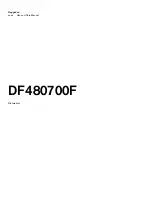
22
TROUBLESHOOTING
If you experience
Possible Causes
Solution
Washer not performing as expected (cont.)
Washer not draining/
spinning, loads are
still wet (cont.)
Load off-balanced.
See “Vibration or Off-Balance” in “Troubleshooting” section for
more information.
Check plumbing for correct drain
hose installation. Drain hose extends
into standpipe farther than 4.5"
(114 mm).
Check drain hose for proper installation. Use drain hose form
and securely attach to drainpipe or tub. Do not tape over drain
opening. Lower drain hose if the end is higher than 72" (183 cm)
above the floor. Remove any clogs from drain hose.
Not using HE detergent or using
too much HE detergent.
Suds from regular detergent or using too much detergent can
slow or stop draining or spinning. Use only HE detergent. Always
measure and follow detergent directions for your load. To remove
extra suds, select RINSE. Do not add detergent.
Incorrect or wrong wash
or rinse temperatures
Check for proper water supply.
For permanent installations, make sure that hot and cold inlet
hoses are not reversed. For portable installations, adjust water
temperature at faucet.
For permanent installations, both hoses must be attached to
both washer and faucet and have both hot and cold water
flowing
to inlet valve.
Check that inlet valve screens are not clogged.
Remove any kinks in hoses.
Load not rinsed
Check for proper water supply.
For permanent installations, make sure hot and cold inlet hoses
are not reversed.
Hoses must be attached and have water flowing to the inlet
valves or faucet.
For permanent installations, both hot and cold water faucets
must be on. For portable installations, sink faucet must be on.
Inlet valve screens on washer may be clogged.
Remove any kinks in the inlet hose.
Not using HE detergent or using
too much HE detergent.
The suds from regular detergent can cause the washer to
operate incorrectly.
Use only HE detergent. Be sure to measure correctly.
Always measure detergent and follow detergent directions based
on load size and soil level.
Washer may be tightly packed.
The washer is less efficient at rinsing when load is tightly packed.
Load items in loose heaps evenly around the washplate.
Use cycle designed for the fabrics being washed.
Add only 1 or 2 additional items after washer has started.
Sand, pet hair, lint, etc.,
on load after washing
Heavy sand, pet hair, lint, and
detergent or bleach residues may
require additional rinsing.
Run an additional Rinse cycle.
Load is tangling
Washer not loaded as recommended. Load items in loose heaps evenly around the washplate.
Reduce tangling by mixing types of load items. Use the
recommended cycle for the type of items being washed.
Wash action and/or spin speed too
fast for load.
Select a cycle with a slower wash action and slower spin speed.
Note that items will be wetter than when using a higher speed spin.
Not cleaning or
removing stains
Wash load not completely covered
in water.
Washer senses load size and adds correct amount of water.
This is normal and necessary for clothes to move.
Added more water to washer.
Do not add more water to washer. Adding water lifts the items
off the washplate, resulting in less effective cleaning.
Washer not loaded as recommended. Load items in loose heaps evenly around the washplate.
Add only 1 or 2 additional items after washer has started.
First try the solutions suggested here for assistance and to possibly avoid a service call.
Summary of Contents for WTW2000HW
Page 2: ...2 WASHER SAFETY ...




































